What DPICM Cluster Munitions Are And Why Ukraine Wants Them So Bad
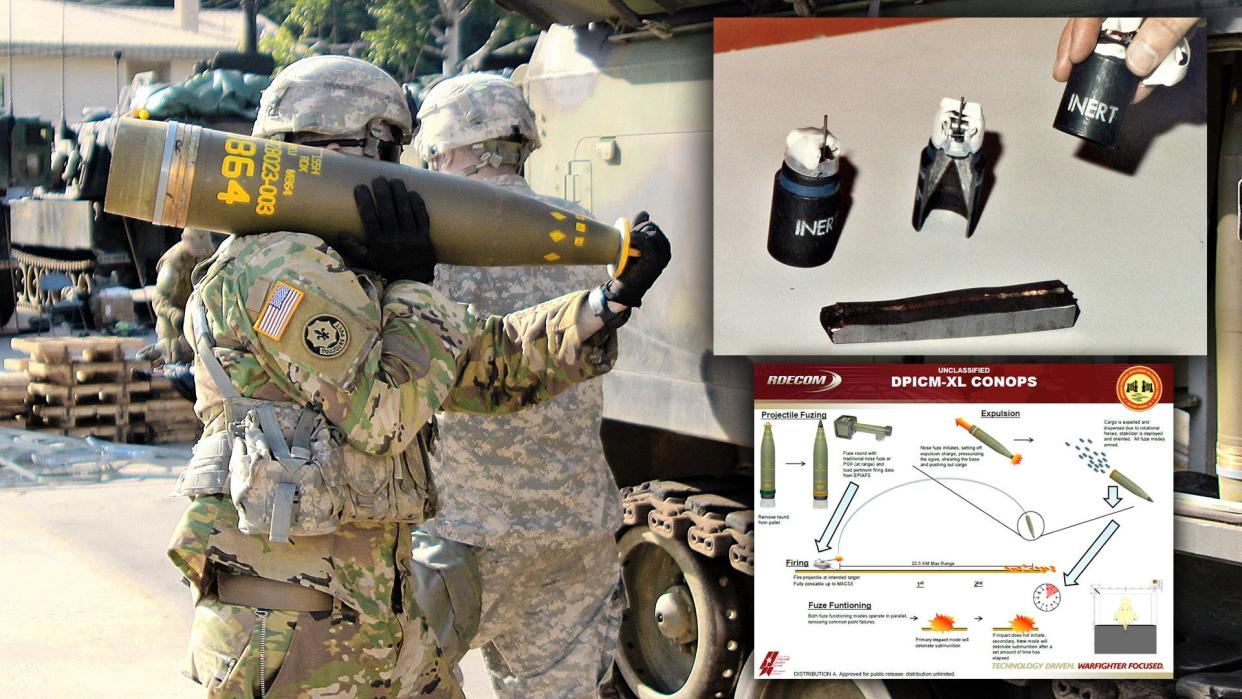
The U.S. military has confirmed that there are ongoing deliberations about the possibility of sending certain types of so-called Dual-Purpose Improved Conventional Munitions (DPICM), a family of cluster munitions, to Ukraine. A decision to provide these weapons could come at any time. Though they are highly controversial, the Ukrainians have been increasingly seeking these kinds of weapons, which could be especially useful in uprooting dug-in Russian units that inhabit created vast trench networks and for tackling large enemy formations, including some armored forces, in open terrain.
Pentagon Press Secretary Air Force Brig. Gen. Pat Ryder spoke to the ongoing discussions about sending DPICMs to Ukraine at a press conference earlier today. This follows multiple recent media reports that say that President Joe Biden is close to approving the transfer of these cluster munitions from U.S. military stockpiles to Ukraine. The President of the United States has the authority to send military aid in this way through a process known as a "drawdown" and Ukrainian forces have already received billions of dollars worth of American weapons and other materiel in this way.
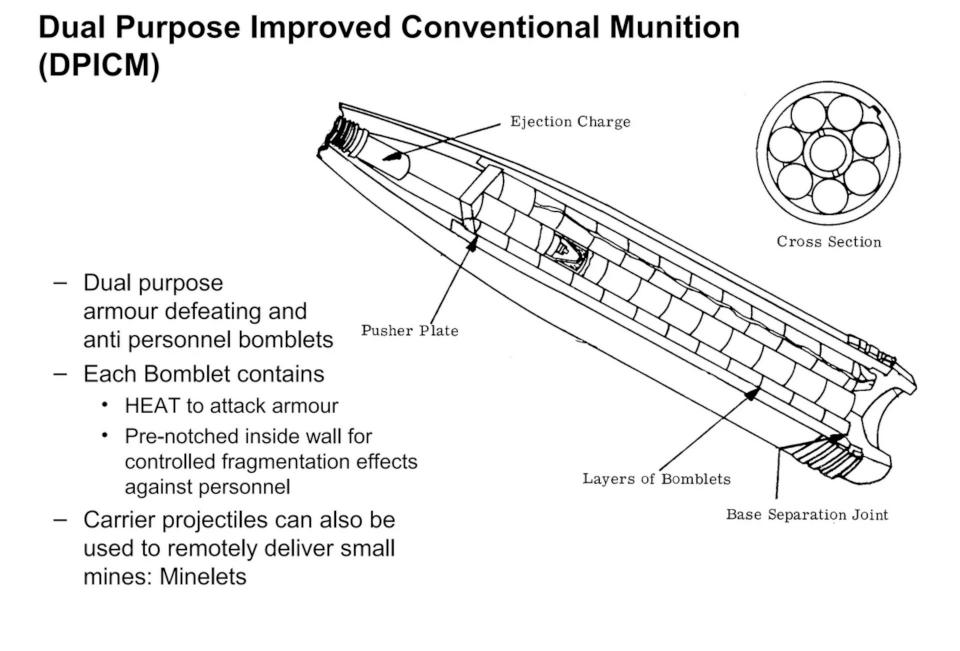
"So in terms of DPICM, I don't have anything to announce today," Ryder said. "As you know, that is something that is under consideration."
DPICM is a general category that includes various types of artillery shells and rockets loaded with multiple types of submunitions that are all designed to function in roughly the same way. The bulk of the production of DPICM-loaded rounds occurred between the 1970s and 1990s. This included shells for 105mm, 155mm, and 203mm howitzers, as well as 227mm artillery rockets that can be fired from the M270 Multiple Launch Rocket System (MLRS) and M142 High Mobility Artillery Rocket System (HIMARS) launchers.
https://www.youtube.com/watch?v=IroOVamQZHQ
Some versions of the Army Tactical Missile System (ATACMS) short-range ballistic missile also had DPICM-filled warheads. Since last year, Ukraine has been very publicly asking for ATACMS, versions of which also have large unitary high-explosive warheads, separate from any discussion about cluster munitions. To date, the U.S. government has resisted those appeals, generally citing concerns about their employment prompting new levels of escalation from Russia, though separate reports indicate that position may now be softening.
https://www.youtube.com/watch?v=Ipr_hPAcR_Q
DPICM evolved from the earlier Improved Conventional Munition (ICM) series of cluster munitions. The "dual-purpose" comes from the fact that the DPICM submunitions, which the U.S. military refers to as "grenades," are designed to be at least somewhat effective against armored vehicles, as well as softer targets like unarmored vehicles and troops.
https://www.youtube.com/watch?v=beiD1IpRtvY
Though there are multiple types of DPICM submunitions, they are all designed in the same basic way, with a shaped charge intended to defeat armor surrounded by a casing specifically structured to send lethal fragments flying in all directions. The submunitions, which are similar in size and weight to a typical hand grenade, are unguided, but each one has a tassel-like piece of cloth at the top that helps stabilize it as it falls. DPICM-filled artillery rounds and other munitions generally eject the submunitions from the rear of the projectile or warhead after it reaches a set point in its trajectory.

Depending on the exact type of DPICM munition and how it is employed, each one can saturate a target area encompassing many thousands of square feet. For example, a single M26 227mm artillery rocket, loaded with 644 M77 DPICM submunitions, can spread submuntions across a circular-shaped area roughly 656 feet (200 meters) in diameter — nearly 50,000 square feet. The effected area can also vary based on the dispersal height and other dynamics.
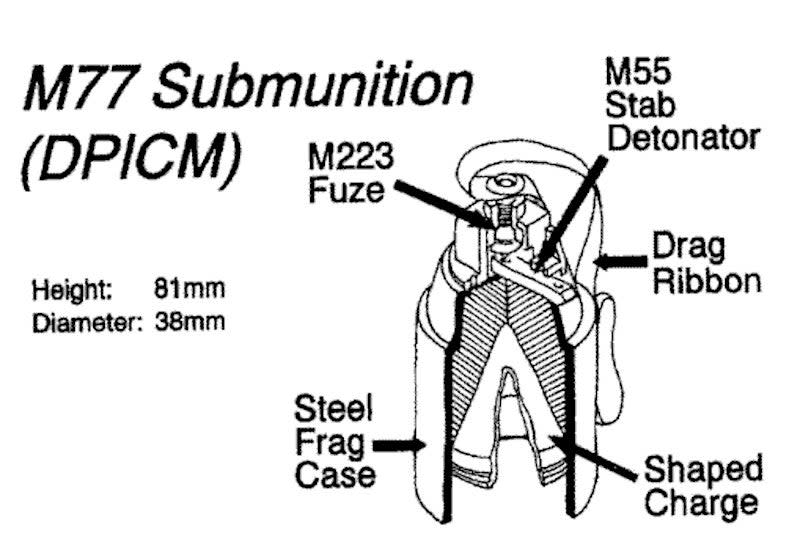
For Ukrainian forces, there are a number of clear potential use cases where DPICM-loaded munitions could be very useful. Ukraine already has M142 HIMARS and variants and derivatives of the M270 in service, as well as an array of NATO-standard 155mm and 105mm howitzers, that can fire different DIPCM types. There is also evidence of U.S.-made 203mm high-explosive artillery shells in Ukraine being used as ammunition for the country's Soviet-era 2S7 Pion howitzers.
https://twitter.com/DefenceU/status/1573246374388420608 https://twitter.com/michaelh992/status/1676286010294935557 https://twitter.com/UAWeapons/status/1596820813768192000
Ukraine's counter-offensive has been slow-going so far due to significant Russian defenses, including minefields and especially vast trench lines. Trenches can be very resilient to indirect fire, such as traditional artillery firing rounds with unitary warheads. Direct fire, such as from cannons and tank guns, is even less effective. It can take significant quantities of unitary high-explosive artillery rounds fired indirectly to saturate them from above. Even then, their effectiveness can be limited against entrenched troops. Cluster munition artillery shells and rockets have the ability to cover much more ground and do so faster with a smaller number of total shells. Combine this with the fact that the submunitions that are deployed from them can fall directly into trenches, resulting in devastating effects.

In addition, since Russia launched its all-out invasion last year, there has been clear evidence that Ukrainian forces are routinely presented with the opportunity to hit large enemy concentrations, including groups of vehicles, with artillery. Again, it would take a greater volume of unitary rounds and more time to saturate the same total area, which in these instances could also give Russian forces the opportunity to continue and advance or just more time to reposition and/or seek cover.
https://twitter.com/Aviation_Intel/status/1674615874312085511
The points about the total number of rounds required to sufficiently saturate a target area are important in their own right given the volume of artillery shells and rockets Ukrainian forces, as well as their Russian opponents, have been expending in the course of the fighting. There have been reported shortages and rationing of rounds on both sides. Sourcing additional shells has become a desperate global operation for both sides. One could even argue that the outcome of the war depends heavily on who can sustain a greater supply of artillery rounds over the long term. So sending DPICM-loaded shells and rockets to Ukraine would have the additional benefit of simply providing the country with more useful ammunition.
Sending DPICM-filled munitions to Ukraine would help with "alleviating pressure on U.S. and allied munitions supplies," Republican members of Congress specifically noted in a joint letter calling for DPICM to be included in future aid for Ukraine that was sent to President Biden in March. "The United States has nearly three million of these rounds in its inventory – much of it located on U.S. and allied bases in Europe."
"A single [DPICM] round can achieve a similar or greater operational effect as five or more rounds armed with GMLRS-U [227mm Guided Multiple Launch System artillery rockets with unitary warheads] or other high-explosive warheads," that letter also said.
The full two-page letter is seen below.

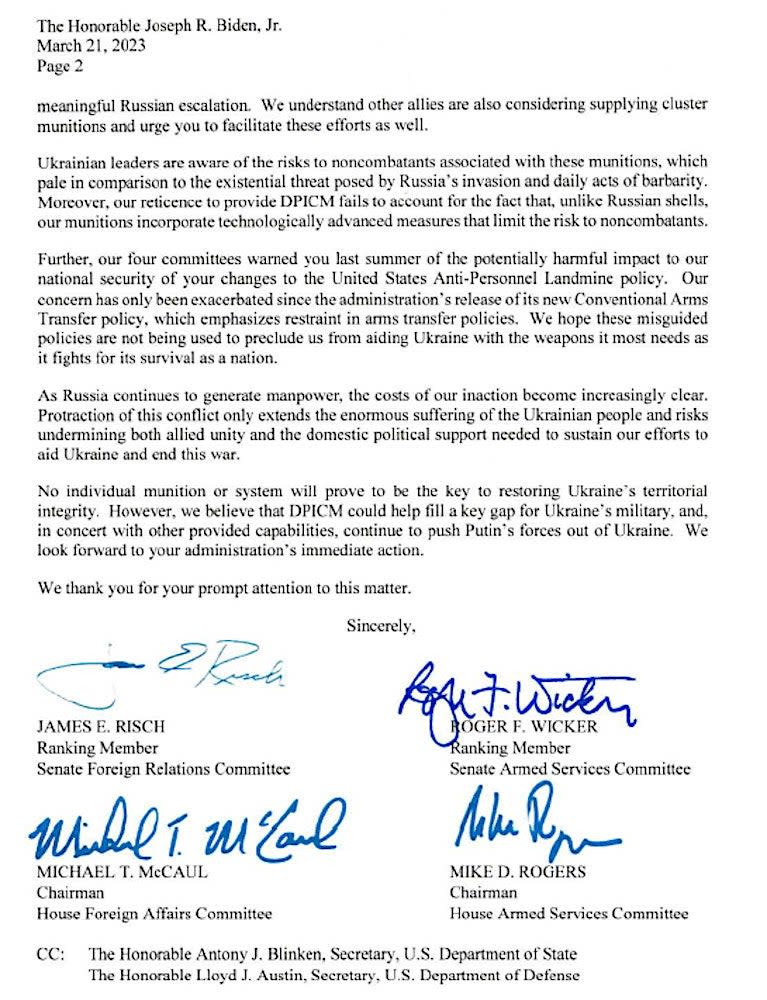
Cluster munitions, including DPICM, are controversial because of the potential for unexploded submunitions to present serious hazards, especially to civilians, well beyond the end of any particular conflict. DPICMs and similar submunitions can kill or maim a person, and have often been cited as being particularly dangerous to children given that they can be mistaken for toys.
Experts have also highlighted how high failure rates can present serious risks to friendly forces that then have to move through areas where these munitions have been used.
More than 100 countries have agreed to stop using most types of cluster munitions under the Convention on Cluster Munitions. Despite how it is commonly reported, the Convention does not prohibit the use of all types of cluster munitions, as you can read more about here, though it does ban the use of DPICM.
This is somewhat moot given that the United States and Ukraine, as well as Russia, are not signatories to the Convention on Cluster Munitions. However, a number of Ukraine's other foreign partners, including many members of NATO, are party that agreement. Concerns about potential rifts between the United States and its allies and partners over this issue have reportedly been a major reason why no DPICMs deliveries have been made to date.
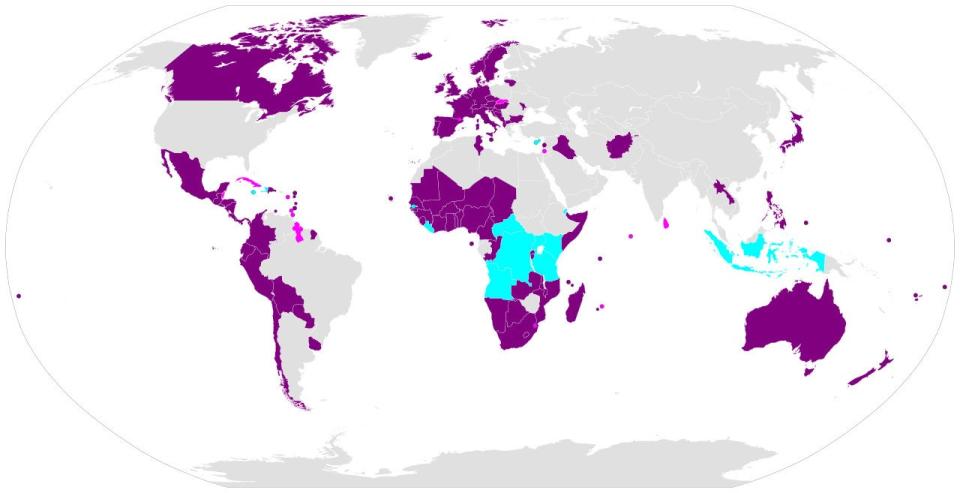
In 2008, at the very tail end of President George W. Bush's tenure in office, then-Secretary of Defense Robert Gates did put a policy into place calling for the elimination of cluster munitions in U.S. inventory with failure rates above one percent. For nearly a decade after, the U.S. military was steadily moving away from cluster munitions more generally in favor of alternative options. The policy was suspended in 2017 under Preisdent Donald Trump. Congress has since blocked the production, use, or transfer of cluster munitions that do not meet the one percent standard, but the Biden administration officials are of the view this can be waived by citing vital national security interests, according to a report from The Washington Post.
The failure rates of different DPICM munition types are a matter of significant debate. One U.S. Army study in 2000 determined that up to an average of 14 percent of at least some lots of these submunitions could malfunction. Dud rates as high as 20 percent have been documented during past conflicts.

Issues in particular with the sensitivity and reliability of the fuzes in certain DPICM submunitions, as well as older ICM submunitions, especially when presented with certain environmental factors, are well established.
For example, "improved conventional munitions (lCM) should not be used in thick foliage and water-filled rice paddies," one U.S. Army jungle warfare manual from 1982 specifically notes. "The ICM submunitions may hang up in heavy foliage or fall undetonated to the ground, creating a hazardous area, or they may submerge in water, rendering them ineffective."
The U.S. military insists that newer DPICM types from more recent production lots are significantly more reliable. Certain submunition types were either built with fuzes designed to self-destruct or otherwise render themselves inert after a certain period of time, or were retrofitted with such fuzes. Those safety features have produced mixed results by the U.S. military's own admission.
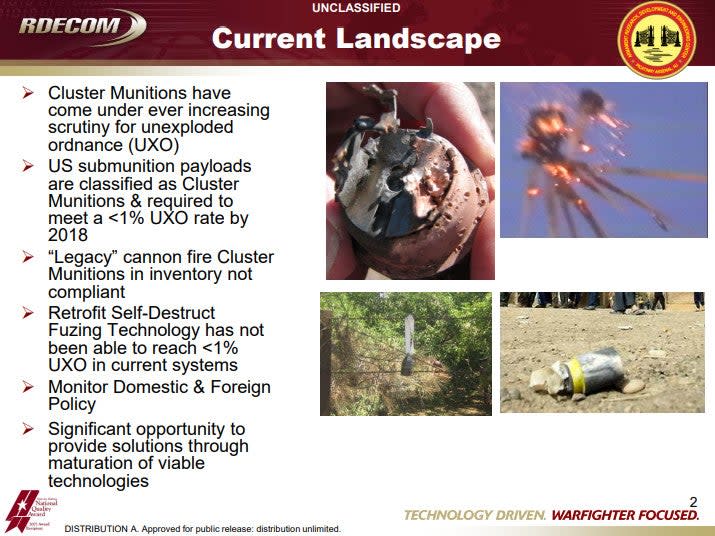
"I will say that we have multiple variants of DPICMs in our stocks and the ones that we are considering providing [to Ukraine] not be... variants with dud rates that are higher than 2.35 percent," Pentagon Press Secretary Ryder said at the press conference earlier today. "We are aware of reports out there from several decades ago that indicate that certain 155mm DIPCMs have higher dud rates. So we will be carefully selecting rounds with lower dud rates for which we have tested."
Experts have called into question the testing methodology the U.S. military may have used to determine those failure rates.
https://twitter.com/marcgarlasco/status/1677047511557480448?s=20
Arguments have also been made that the risks are acceptable no matter what given the circumstances Ukraine is facing now, together with Russia's own unrestricted use of cluster munitions and scatterable mines. Ukrainian forces have been using other types of cluster munitions themselves for months now. Large areas of Ukraine will require significant demining and other work to remove other unexploded ordnance regardless after the current conflict concludes. This work will likely last many years.
"Ukrainian leaders are aware of the risks to noncombatants associated with these munitions, which pale in comparison to the existential threat posed by Russia's invasion and daily acts of barbarity," the Republican members of Congress wrote in their March letter to Biden. "Moreover, our reticence to provide DPICM fails to account for the fact that, unlike Russian shells, our munitions incorporate technologically advanced measures that limit the risk to noncombatants."
That letter also highlighted the potential second-order impact that dud submunitions might have in helping to funnel Russian units into areas more favorable to Ukrainian forces or otherwise forcing them to concentrate where they would be more easily targeted.
Another argument for giving these weapons to Ukraine is that they would be actively choosing to use them on their own territory. They accept the risks of doing so and are not forcing their long-term effects on another state.
It is also worth noting that the U.S. military has already publicly acknowledged the inclusion of cluster munition artillery shells loaded with scatterable anti-tank mines (which also present a threat to other kinds of vehicles) in previous aid packages for Ukraine. It is unclear why the 155mm Remote Anti-Armor Mine (RAAM) rounds did not prompt the same kind of policy debate.
https://twitter.com/RALee85/status/1624393791221137409
Ukraine has also reportedly asked for U.S. Mk 20 Rockeye II air-dropped cluster bombs in the past, but for the novel purpose of using their submunitions to arm small drones.
Whatever the case, the sluggish progress of Ukraine's counter-offensive, so far, has reinvigorated calls to send cluster munitions, as well as ATACMs and other weapons.
“I’m grateful to the U.S. as the leaders of our support," Ukrainian President Volodymyr Zelensky told CNN's Erin Burnett in a recent interview, with the help of a translator. "But I told them as well as the European leaders that we would like to start our counteroffensive earlier, and we need all the weapons and materiel for that. Why? Simply because if we start later, it will go slower."
It is, of course, important to note that no single weapon system is likely to be solely responsible for accelerating Ukrainian advances or otherwise changing the course of the conflict. As we already highlighted, Russian forces had many months to prepare extensive defenses. Russia's units are now operating in areas where it is easier for them to call upon air and artillery support, as well as take advantage of the protection of more robust air and missile defenses.
All told, despite being controversial, Ukraine clearly believes the benefits that DPICM could offer its forces in the current phase of the conflict ultimately outweigh the risks. Now it's up to the U.S. to agree or not with that conclusion.
Contact the author: joe@thedrive.com

